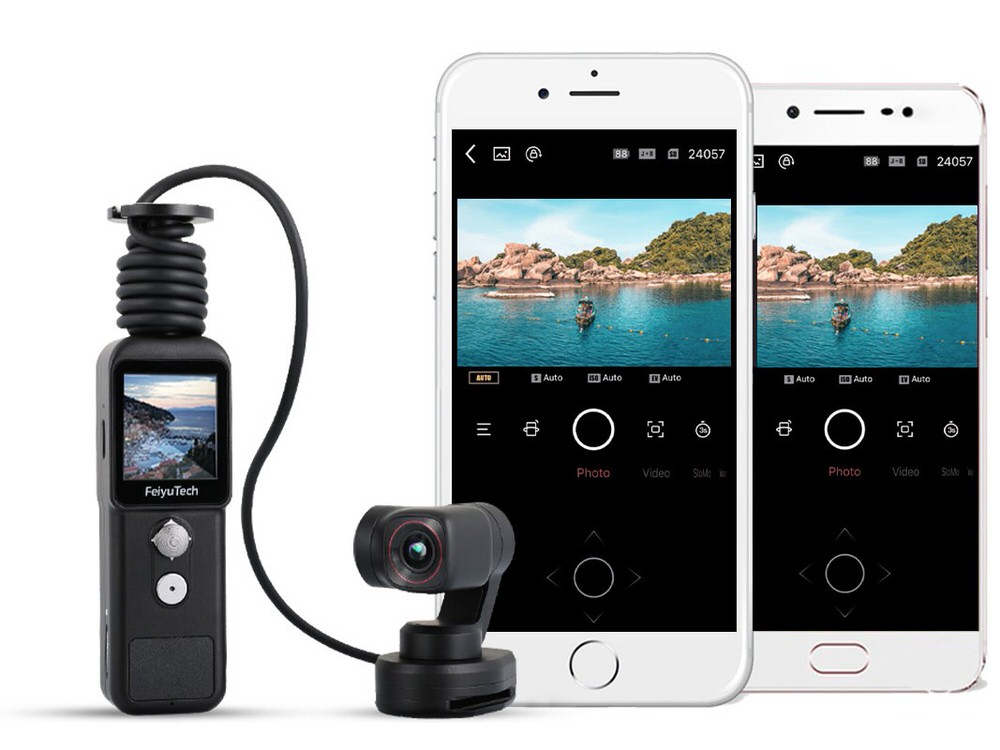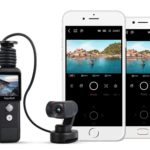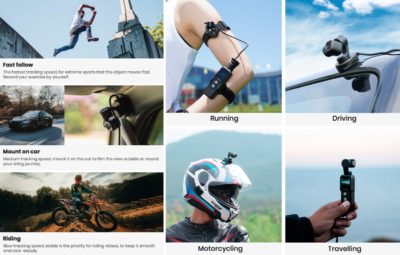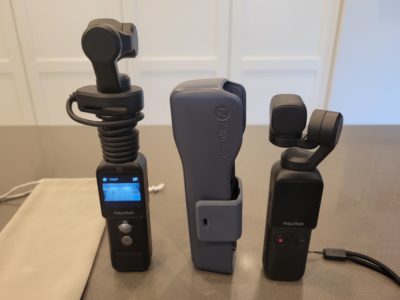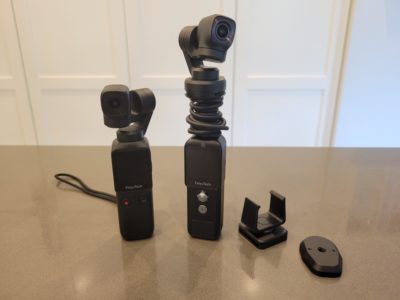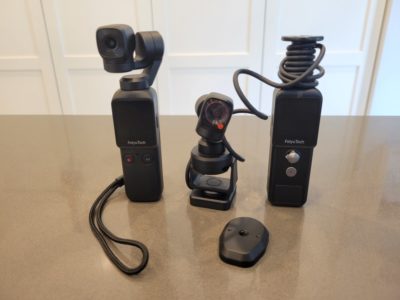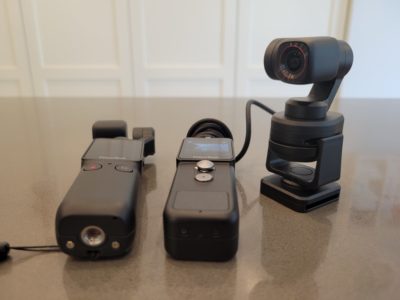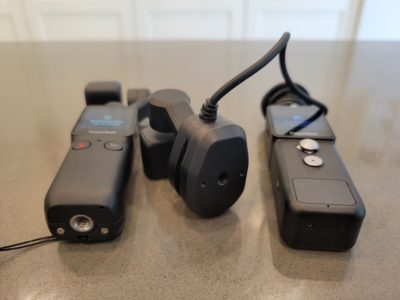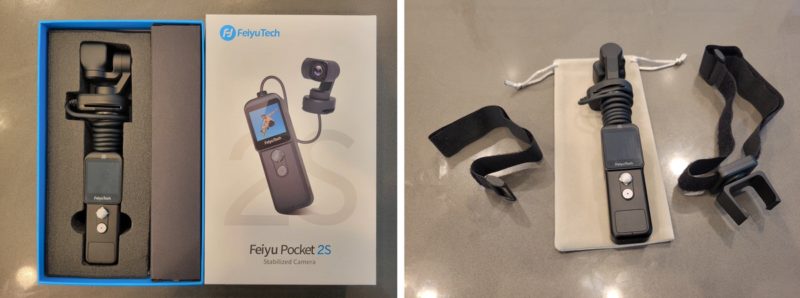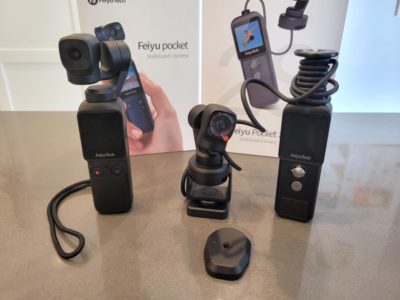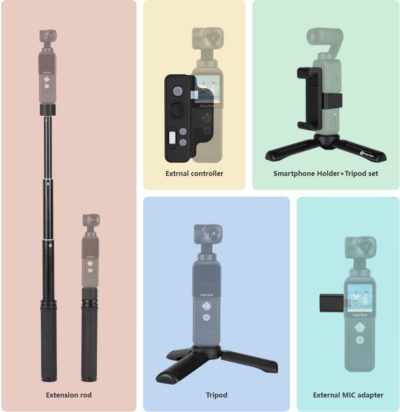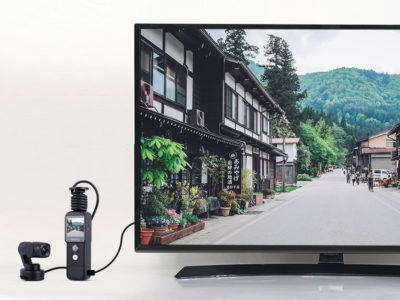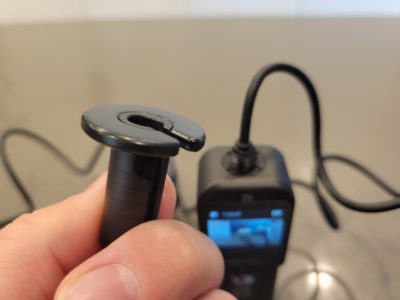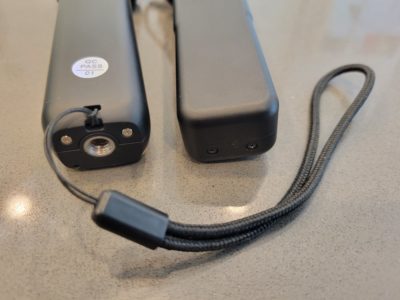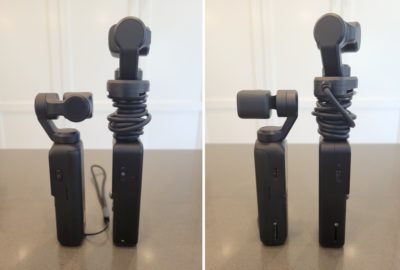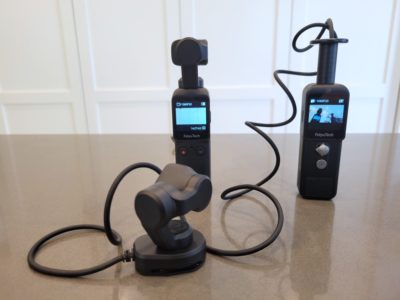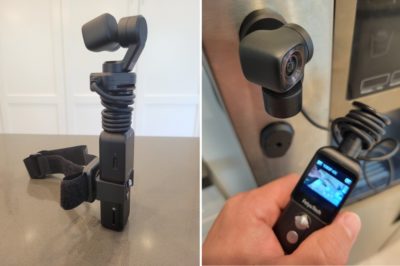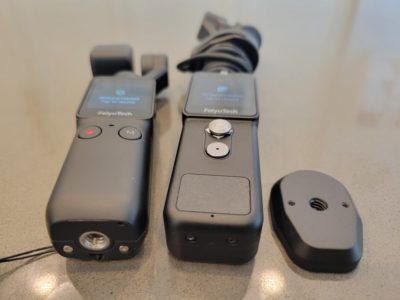Feiyu Pocket 2 Series (2-in-1 Gimbal Camera)
Pros
- Compact and lightweight
- Excellent value
- Detachable, 130° FOV camera
- Great Sony sensor with fast focus
- Built-in WiFi for App control
Cons
- Image sensor slightly inferior to DJI Pocket 2
- Pocket 2S: Relatively bulky
- Pocket 2S: Cable or Camera head could more easily get damaged
- Object tracking needs work
- Battery not replaceable
Contents
Next Evolution
Last summer, I took a look at the Feiyu Pocket and how it compared to the industry-leading DJI Osmo Pocket. Both promised a revolutionary way to take vlogging to the next level by combining a wide-angled action camera with a gimbal for smooth, portable videos. The Feiyu gave the DJI “a run for its money with more included accessories and features for a much lower price.” I then added that its performance was not as fast in some areas, but that most people would not know the difference.
Fast-forward to the end of 2021, and Feiyu released a successor with the Pocket 2 and Pocket 2S. The latter caught my eye the most with its ability to have the camera detached and mounted elsewhere.
In this review, I will mainly compare the Feiyu Pocket 2S with the Pocket 2 and Pocket.
Why a Pocket Gimbal?
A coworker once told me shortly after I became a first-time dad, that my Canon 5D Mark IV DSLR would probably be used less than the smartphone. He was absolutely right! I had been finding myself taking out my phone more times to capture moments of my children’s lives than a bulky, professional camera. It boiled down to what was always carried with me and how fast recording could be started.
For those very same reasons, a pocket-sized gimbal camera is more easily available and convenient to shoot with than trying to physically stabilize a DSLR or smartphone with breathing, holding, and moving techniques — and potentially missing or ruining the moment. The Feiyu and DJI Pocket cameras were designed for convenience, traveling, and vlogging to achieve beautiful, smooth videos from devices that can easily fit in one’s pocket.
Feiyu vs DJI Pocket Model Comparison
| Feiyu Pocket | DJI Osmo Pocket | Feiyu Pocket 2 | DJI Pocket 2 | Feiyu Pocket 2S | |
|---|---|---|---|---|---|
| Price (Amazon) | $199 | $199 | $359 | $349 | $399 |
| Dimensions | 4.9 x 1.6 x 1.1 in 12.4 x 4.1 x 2.9 cm | 4.8 x 1.5 x 1.1 in 12.2 x 3.7 x 2.9 cm | 4.9 x 1.6 x 1.1 in 12.4 x 4.1 x 2.9 cm | 4.9 x 1.5 x 1.2 in 12.5 x 3.8 x 3 cm | 6.1 x 1.6 x 1.1 in 15.4 x 4.1 x 2.9 cm |
| Weight | 4.1oz/ 115g | 4.1oz/ 116g | 4.5oz/ 127g | 4.1oz/ 117g | 6.3oz/ 179g |
| Resolution | 4K @ 60 fps | 4K @ 60 fps | 4K @ 60 fps | 4K @ 60 fps | 4K @ 60 fps |
| Sensor | 1/2.5" 8.5MP Sony | 1/2.3" 12MP | 1/2.3" 12MP Sony | 1/1.7" 64MP | 1/2.3" 12MP Sony |
| Lens FOV | 120° f/2.8 | 80° f/2.0 | 130° f/2.0 | 93° f/1.8 | 130° f/2.0 |
| Camera | Fixed | Fixed | Fixed, Magnetic | Fixed | Detachable, Magnetic |
| Gimbal | 3-axis | 3-axis | 3-axis | 3-axis | 3-axis |
| Screen | 1.3" Touch | 1.08" Touch | 1.3" Touch | 1.08" Touch | 1.3" Touch |
| Control (Base) | Touch, Buttons | Touch, Buttons | 5-way Joystick, Touch, Buttons | Touch, Buttons | 5-way Joystick, Touch, Buttons |
| WiFi | Yes | Optional | Yes | Optional | Yes |
| HDMI Output | No | No | No | No | Yes (micro) |
| Speakers | No | Optional | Built-in | Optional | Built-in |
| Storage | 512 GB max microSD | 256 GB max microSD | 512 GB max microSD | 256 GB max microSD | 512 GB max microSD |
| Battery | 875 mAh @ 7.7V | 875 mAh @ 7.7V | 875 mAh @ 7.7V | 875 mAh @ 7.7V | 875 mAh @ 7.7V |
| Mount 1/4" | Yes | Optional | Yes | Optional | Yes |
| App Support | Feiyu Cam | DJI Mimo | Feiyu Cam | DJI Mimo | Feiyu Cam |
DJI holds the advantage with its superior image quality and smoother stabilization, but the Feiyu becomes a compelling choice with its value proposition, feature set, and included accessories that DJI charges extra for. The Feiyu Pocket 2S is unique with its magnetic, detachable camera head that can be mounted to anything metallic, opening doors to creative use cases like attaching onto a helmet or car while maintaining remote control.
What’s Good? What’s Bad?
Pros
- Pocket 2S has a unique, detachable camera head
- Magnetic base allows mounting to metallic surfaces (helmet, car, light pole, etc.)
- Example: Film a car ride with camera on top while controlling lens direction without getting out of the seat
- Camera can be placed up to 3′ away from its body
- Magnetic base allows mounting to metallic surfaces (helmet, car, light pole, etc.)
- Small, compact, lightweight design, making it easy to bring on trips
- Not as small as its predecessor or the Pocket 2 due to its extended neck (adds 1.2″ height)
- Built-in Camera with built-in image stabilization
- No smartphone needs to be attached (though the Pocket’s functionality can be enhanced with an iOS/Android app, the “Feiyu Cam”, via WiFi)
- Suitable for vlogging and image-stabilized action recording
- Compact at 6.1″ x 1.6″ x 1.1″ and 6.3oz (Pocket 2 is 4.5oz)
- Improved image sensor and lens
- Better image quality and much improved low-light recording than the Feiyu Pocket, but lags behind DJI’s Pocket 2
- Lens field-of-view is superior at 130° (DJI Pocket 2 is only 93°)
- Allows for wider capture of the scene, keeping more in view
- Stabilization worked VERY well
- Enabled by a 3-axis mechanical and 3-axis electronic stabilization
- DJI only has the mechanical one
- Bounces and FAST movements worked without a glitch
- Axes: -140 to 140 degree tilt, -90 to 90 roll, -254 to 60 pan ranges
- Self-calibrates (and can be reset/re-centered with the push of a button)
- Enabled by a 3-axis mechanical and 3-axis electronic stabilization
- Amazing video quality with f/2.0 lens (up from predecessor’s f/2.8)
- 1/2.3″ Sony CMOS sensor is top-notch, but DJI’s Pocket 2 image and low-light quality outperforms Feiyu’s
- Smooth, slow motion recording
- With a 130 degree wide angle, it rivals the GoPro
- DJI Osmo Pocket only goes 93 degrees (with a faster f/1.8 lens)
- Frame rates
- 4K: 60 fps max / 2.7K: 60 fps max / 1080p: 120 fps max
- Built-in 1.3″ touchscreen LCD (240×240) for live viewing and recordings
- DJI’s is only 1.08″
- MUCH lower cost than DJI Pocket 2 when taking into consideration what DJI charges extra for that Feiyu already includes (features and accessories)
- Joystick (5-Way) built-in (DJI charges extra for this)
- Makes controlling the camera far easier than its predecessor
- Quiet motor
- VERY responsive, fast motor torque with quick auto focus
- Can be oriented in 360 degrees
- Multiple shooting modes
- Breakpoint Shooting – Pause and resume recording so different shots are saved onto the same video. I use this feature a LOT!
- Object/Face tracking to follow the subject, allowing you to vlog or record without much intervention. The Pocket’s camera literally follows you around when set on a table
- Object tracking is only available through the Feiyu Cam app and does not work quite well
- 360 degree POV All-Follow mode
- Timelapse with motion
- Selfie (invoked by triple-tapping the Mode button) with “Beauty enhancement”
- Like the DJI Osmo Pocket, the Panorama mode can stitch several photos together as one seamless image
- Speaker and microphone built-in
- Speaker allows listening of the recording right on the device itself
- DJI and the older Feiyu Pocket do not have a speaker to listen to videos with
- HDMI output built-in
- View videos on the TV/projector in real-time. Pocket 2 nor DJI have this ability
- WiFi built-in
- Allows for additional controls via Feiyu Cam app
- DJI charges extra for WiFi functionality (which also uses up the USB-C port, preventing the DJI from being charged while remotely controlled via WiFi, such as time lapses)
- Smartphone control and viewing
- Control via WiFi (with Feiyu Cam app) or direct USB-C connection
- Video editing with the app
- Motion-sync with phone (move the phone, and the Pocket camera moves the same way)
- Writes to max 512GB microSD card (U3 speed or faster is recommended)
- SanDisk and Kingston are my two, top recommendations for reliable memory cards
- SanDisk Extreme line provides for lifetime warranty
- I always recommend 2 smaller cards over 1 larger one. If one card fails, you won’t lose everything
- SanDisk and Kingston are my two, top recommendations for reliable memory cards
- Material feels, looks, and is packaged professionally
- Built-in Battery lasts about 3.5-4.5 hours, depending on recording mode
- Rechargeable via USB (including battery banks)
- Pocket 2S can be charged while in its protective case, though the case is not yet available at the time of this writing
- Built-in 1/4″ tripod mount (DJI charges extra for this)
- My unit did not come with one. I later found that recent units now include it after customer feedback. How could you miss this in your design, Feiyu?
- Underwater case available for diving up to 130’/40m
Cons
- Image quality and low-light performance, though good, trails DJI’s Pocket 2
- DJI Pocket 2 is more crisp and has higher, dynamic range
- Stabilization works very well, but slightly lags behind DJI’s Pocket 2
- Extended neck (where the cable is wrapped around) makes the Pocket 2S less “pocketable” due to its increased size (Feiyu Pocket 2 does not have this issue)
- Cable cannot be replaced. Concerns about its longevity
- Cable can be unwieldy to wrap back into its stored position
- Camera head is detachable
- Can accidentally fall or be yanked onto the ground and get damaged
- Enables recording in a potentially criminal, secret way
- No wrist strap to attach to the Feiyu Pocket 2/2S itself
- Makes it more likely to accidentally drop the body out of your hand
- DJI’s wrist strap goes onto the protective case and NOT onto their Pocket 2 itself (Odd design choice, DJI!)
- Electronic zoom is not very good. In fact, optical zoom is always better
- No hard case available at the time of this writing, though it is in the works
- Earlier units did not include a built-in 1/4″ tripod mount. How could you miss this in your design, Feiyu?
- Object tracking is only available through the Feiyu Cam app and does not work quite well
- Still images are only 12MP (DJI’s Pocket 2 is 64MP)
- Battery not replaceable
- Not waterproof or water resistant, though an underwater case is available
- Camera tucks away when powered off, ready for safe keeping in the protective case. However, the axes don’t lock in place. You’ll have to hold the camera steady to properly put it into the case
- Similar naming between DJI and Feiyu makes it cumbersome to refer to any particular model (ie. “Pocket 2” – are we talking about DJI’s or Feiyu’s?)
Tips/Notes
-
Be sure to update to the latest firmware to fix any issues that existed with older versions of the gimbal software
Buttons
- Power
- Long press 1 sec: Power on/off
- 1 tap: Switch between video/photo mode or to return to previous menu
- Shutter
- 1 tap: Start/stop video, take photo, or return to main menu
- Long press 3 sec: WiFi on/off
- Mode/Function
- 1 tap: Switch shooting mode – Follow (Default), All-Follow, Pan
- 2 tap: Reset gimbal orientation
- 3 tap: Selfie/Non-Selfie
- Press and hold: Lock on/off
Touch Screen Control
Swipe in the listed direction:
- Left: Switch shooting mode
- Right: Gallery view
- Up: Gimbal control
- Down: Settings
Who Is FeiyuTech?
Feiyu, according to its website, specializes in “video stabilization technology [and] research” and carries a product portfolio for action cameras, smartphones, and still cameras. The Guilin, China, based company was founded in 2007 and originally focused on drone and automation industries, including “flight stabilization systems [and] autopilots” (Source: Wikipedia). This may be where “Fei” in “Feiyu” came from: it translates to “Flying” in Chinese.
Final Thoughts
The Feiyu Pocket 2S is a bit of a hard sell despite of — or because of — its unique feature: a detachable, magnetic camera head. Sure, the camera can be placed on any metallic surface for some very creative shooting options, but adds some concerns about the longevity of the attached cable that is responsible for powering both the camera and the gimbal. The magnet that holds the camera to the body is strong, but would not stop both from getting detached accidentally and contributing to a potentially damaging situation where the lens may smash onto the ground. The neck also adds some bulk (about 1.2″) to the device overall, making it less “pocketable”. After all, the selling feature of a “pocket gimbal” is that it can be easily carried around in a pocket for quick shoots.
With the detachable camera feature set aside, the 2S adds a built-in micro HDMI port for real-time output to a television or projector, a capability that the Pocket 2 or any of the DJI Pocket models offer. The Feiyu Pocket 2 series adds an improved imaging sensor and greater field of view (130 degrees, compared to DJI Pocket 2’s 93 degrees) so more of a scene could be captured with better image quality and low-light performance. Nonetheless, Feiyu still trails DJI in image quality, low-light recording, and (to a lesser degree) stabilization.
Feiyu makes up for the lower — but still quite good — image quality and performance by baking features built-in that DJI would charge you for: WiFi, Tripod mount, Joystick control, and built-in speakers for on-device video playback with sound.
Ultimately, the decision seems to come down to the same conclusion that I had between the Feiyu Pocket and DJI Osmo Pocket: price vs performance. Choose the DJI for better image quality and low-light shooting, or get the Feiyu for better value with decently good videos. Once that choice has been made, the Feiyu Pocket 2S begs the question of whether its detachable camera would meet your unique shooting needs.
For me, the 2S has compelling value with mounting the camera on top of my car roof while driving around and being able to direct the lens from inside the vehicle. This (along with the Breakpoint Shooting feature) enabled epic riding videos where I did not have to edit much. Yet, for day-to-day recording, I would gravitate more towards either the Feiyu Pocket 2 or DJI Pocket 2 because they are more compact.
Where To Buy
- Handheld Gimbal Stabilizer
- Feiyu Pocket 2S / Pocket 2 / Pocket
- DJI Pocket 2 / Osmo Pocket
- DSLR/Mirrorless Gimbals
Related Posts
- Feiyu Pocket 2-in-1 Gimbal Camera

